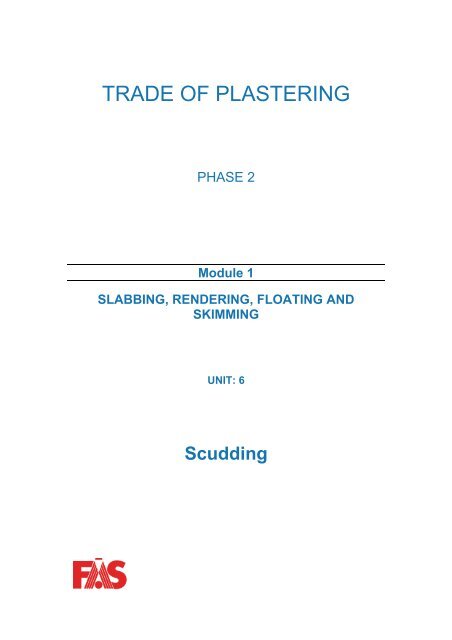TRADE OF PLASTERING - eCollege
TRADE OF PLASTERING - eCollege
TRADE OF PLASTERING - eCollege
You also want an ePaper? Increase the reach of your titles
YUMPU automatically turns print PDFs into web optimized ePapers that Google loves.
<strong>TRADE</strong> <strong>OF</strong> <strong>PLASTERING</strong><br />
PHASE 2<br />
Module 1<br />
SLABBING, RENDERING, FLOATING AND<br />
SKIMMING<br />
UNIT: 6<br />
Scudding
Module 1– Unit 6 Scudding<br />
Produced by<br />
In cooperation with subject matter expert:<br />
Terry Egan<br />
Some images & text courtesy of Gypsum Industries Ltd.<br />
© FÁS - Foras Áiseanna Saothair 2008<br />
Plastering Phase 2 Revision 1.0 July 2008
Module 1– Unit 6 Scudding<br />
Table of Contents<br />
Introduction.................................................................................................................. 1<br />
Unit Objective .............................................................................................................. 1<br />
1.0 Prepare Backgrounds for Scudding ............................................................. 1<br />
1.1 Preparation of Background .......................................................................1<br />
1.2 Cleaning Down and Control of Suction..................................................1<br />
1.3 Function of Scudding.................................................................................2<br />
1.4 Proper Mix Ratio: Sand/Cement/Water.................................................2<br />
2.0 Draw Elevations and Sections of Timber Stud Partition ......................... 2<br />
2.1 Elevations and Sections of Timber Stud Partitions...............................2<br />
Plastering Phase 2 Revision 1.0 July 2008
Module 1– Unit 6 Scudding<br />
Introduction<br />
Welcome to this section of your course which is designed to introduce you the<br />
learner, to scudding and drawing.<br />
Unit Objective<br />
By the end of this unit each apprentice will be able to:<br />
Prepare backgrounds for scudding<br />
Draw elevations and sections of timber stud partition<br />
1.0 Prepare Backgrounds for Scudding<br />
Key Learning Points<br />
Preparation of background – cleaning down and control of suction<br />
Function of scudding<br />
Proper mix ratio: sand/cement/water<br />
1.1 Preparation of Background<br />
All backgrounds must be free from oil, grease, dust and dirt. Solid built<br />
backgrounds, concrete, brickwork, blocks and stone should have no loose<br />
particles. The need to be lightly dampened before plaster is applied.<br />
Sparrow Picking<br />
Where there is dense concrete it should be hacked to roughen it up, this is done<br />
with a hammer and chisel or a light pick hammer. After sparrow picking, it<br />
should be well wetted and then scudded.<br />
1.2 Cleaning Down and Control of Suction<br />
Any background treated with a bonding agent (a liquid applied with a paint<br />
brush over the surface immediately before plastering, making sure that it is not<br />
dry before applying the plaster is applied) must be recognised as a low suction<br />
background. Many of these agents are unsuitable for external plastering and all<br />
them must be used in accordance to manufactures instructions.<br />
Plastering Phase 2 1 Revision 1.0 July 2008
Module 1– Unit 6 Scudding<br />
1.3 Function of Scudding<br />
Before scudding a wall, it should be well wetted and in old buildings any loose<br />
pieces removed. Scudding should always be applied before plastering a wall to<br />
form what is known as a mechanical key i.e. (when the material hits the wall it<br />
expels the air between both, thereby forming a mechanical key, the faster and<br />
harder it's hit the better key you have). This gives a grip for the scratch coat.<br />
1.4 Proper Mix Ratio: Sand/Cement/Water<br />
The materials used should be in 3 parts of sand to 1 part of cement mixed to a<br />
soft consistency and applied with a scudder. This mix has three materials the<br />
sand (an inert material) is the aggregate, the cement is the binder or matrix and<br />
water to enable the mix to set.<br />
2.0 Draw Elevations and Sections of<br />
Timber Stud Partition<br />
Key Learning Point<br />
Elevations and sections of timber stud partitions<br />
2.1 Elevations and Sections of Timber Stud<br />
Partitions<br />
A non load-bearing stud partition is constructed from 100mm x 50mm or<br />
75mm x 50mm rough white deal and is used to divide a floor into rooms or<br />
offices.<br />
Plastering Phase 2 2 Revision 1.0 July 2008
FÁS Learning Innovation Unit<br />
Tallaght Training Centre<br />
Cookstown Road<br />
Cookstown Industrial Estate<br />
Tallaght<br />
Dublin 24
















